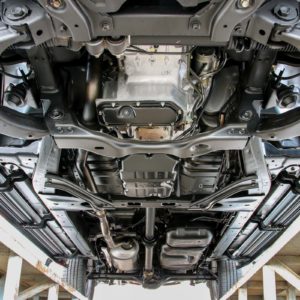The evaporative emission control (EVAP) system prevents fuel vapors from escaping into the atmosphere by routing them back to the engine and burning in the normal combustion process. The EVAP system has a purge valve that opens and lets fuel vapors enter the engine through the intake manifold. If the powertrain control module (PCM) detects an issue with the valve, code P0458 will be logged by on-board diagnostics (OBD).
What Does the P0458 Code Mean?
Diagnostic trouble code P0458 stands for “Evaporative Emission System Purge Control Valve Circuit Low.”
The canister purge valve, also known as the canister purge (CANP) solenoid, is controlled by the PCM during purging, which is the process of mixing unburned gasoline with the existing air-fuel charge.

The purge valve sits on the line between the EVAP canister and intake manifold and only opens when the engine is running under certain operating conditions. This then creates a vacuum in the EVAP system.
The PCM uses the purge valve to diagnose the EVAP system by keeping it open and the canister vent solenoid closed. This causes the fuel tank pressure sensor to determine whether or not a vacuum is present if the system is sealed. If the PCM detects that the EVAP system has flow when it shouldn’t, the computer will log a P0458 code.
Note: The definition of code P0458 might be different depending on the vehicle manufacturer. Consult the appropriate repair manual or repair database for the exact code definition.
What are the Common Causes of the P0458 Code?
- Faulty EVAP purge solenoid
- PCM issues
- Wiring issues

What are the Common Symptoms of the P0458 Code?
- Illuminated check engine light
- Decreased fuel economy
- Smell of gasoline inside the cabin
How to Diagnose the P0458 Code
DTC P0458 is a generic powertrain code that can be logged in vehicles with an OBD-II system. While this might be the case, keep in mind that the steps for diagnosing this trouble code can vary, depending on vehicle specifications.
If you’re not familiar with the process of diagnosing trouble codes, it might be best to have a trained professional do the job for you. Otherwise, you can go ahead and do it yourself.
To help you out, here is a video you might want to watch before starting.
How to Fix the P0458 Code
Without the right tools and technical knowledge, it can be hard to repair a P0458 code. Under these circumstances, it might be best to bring your vehicle to the nearest repair shop and have a certified mechanic resolve the issue. But if you think you have the automotive know-how to work on your vehicle, make sure to follow the right steps and observe the necessary protocols before you begin.
Keep in mind that there’s no magic bullet that will resolve all trouble codes, which is why it’s important to have the right resources. Guides like those from Chilton or an ALLDATA subscription contain vehicle-specific repair information, so you might want to check those out before you begin.
Where to Find Replacement Parts to Clear Code P0458
There are many possible explanations why your PCM has logged DTC P0458, and one of the most common is a bad EVAP purge solenoid. If you’ve determined that your vehicle’s PCM logged this trouble code because of this part, it’s best to replace it to clear the symptoms mentioned above.
On the bright side, it shouldn’t be too difficult to get a replacement that fits your vehicle at CarParts.com. Start shopping by using our vehicle selector to narrow down our catalog to compatible EVAP purge solenoids. Then, adjust the filters based on your preferred brand, price, and features. With only a few clicks, you can find what you need and check out securely.
We source our car components from the most reliable names in the industry to guarantee their quality. On top of that, our warehouses are located all over the US, meaning you can receive your order in as fast as two business days.
Take advantage of our competitive prices. Shop now to clear this trouble code in no time!
Any information provided on this Website is for informational purposes only and is not intended to replace consultation with a professional mechanic. The accuracy and timeliness of the information may change from the time of publication.


















